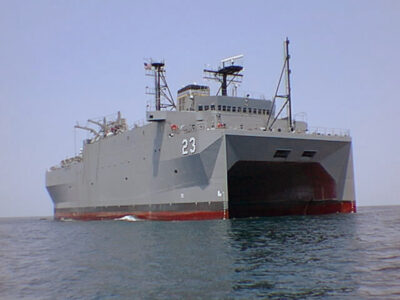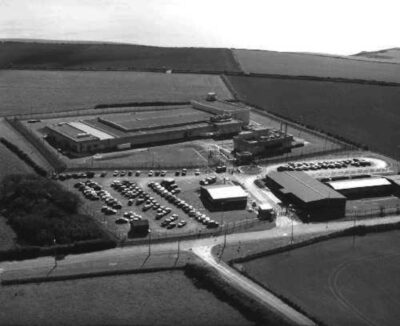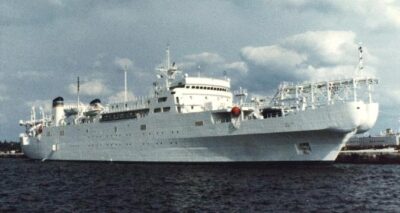A nation must think before it acts.
Atlantic Bastion represents the Royal Navy’s future plan for anti-submarine capabilities, defending the North Atlantic against the threat from the Russian submarine fleet. First formally revealed in the United Kingdom’s recent Strategic Defence Review, the program brings in emerging technologies to achieve persistent situational awareness in what is an extremely complex maritime domain. While the Russian threat in the North Atlantic is persistent and tackling it requires innovative thinking, a successful Atlantic Bastion will require the solution of a range of technological challenges and the answering of questions that have not yet been resolved in the brief plans that have emerged.
Atlantic Bastion and the Strategic Defence Review
The Strategic Defence Review[1] heralded the introduction of Atlantic Bastion, which represents the Royal Navy’s strategic framework for safeguarding the North Atlantic in support of British and NATO interests, in response to the evolving undersea threat posed by a modernizing Russian submarine fleet. This is intended to enhance British anti-submarine warfare (ASW) capabilities, a vital component of European collective defense. The concept envisions a layered and integrated sensor network that spans surface, subsurface, and aerial domains and is coordinated across multiple stakeholders, including the Royal Air Force (RAF), UK Strategic Command, the UK Hydrographic Office, NATO, and industry partners. When fully implemented, the project aims to bolster the Royal Navy’s capacity to detect, track, and deter submarines across the North Atlantic, particularly around the vital GIUK (Greenland-Iceland-UK) gap.
The Royal Navy will field a technologically advanced force centered around the Type 26-class ASW frigate, designed with modular mission bays to enable agile upgrades and iterative capability development, complemented by uncrewed surface and underwater vehicles. These assets will be fused with AI-enabled acoustic detection systems and integrated within a broader digital targeting network to enhance situational awareness and accelerate targeting processes. Atlantic Bastion aims to enhance maritime surveillance, free up crewed warships for other missions, and fulfill an evolving strategic requirement to protect sea lines of communication and counter the threat from the Russian submarine fleet.

The nuclear-powered submarine Krasnoyarsk is seen during a flag-raising ceremony at the naval base in the northern city of Severodvinsk, Russia, December 11, 2023. Sputnik/Kirill Iodas/Pool via REUTERS
The Russian Threat
The Russian Navy maintains one of the most formidable and varied submarine fleets in the world, of around 64 vessels – strategic ballistic missile submarines (SSBNs), nuclear-powered attack submarines (SSNs), and diesel-electric attack submarines (SSKs).[2] These submarines are stationed across Russia’s geostrategically important bases, including those on the Kola peninsula and in the Far East in Vladivostok, enabling Russia to project maritime power in both the Atlantic and Pacific theaters.
Submarines play a pivotal role in Russia’s naval doctrine, underpinning both conventional and nuclear capabilities. They are central to the Kremlin’s broader deterrence strategy and would contribute significantly to Russia’s posture in any potential near-peer military conflict. Their powerful offensive capabilities, ranging from torpedoes to long-range cruise and ballistic missiles, makes them vital assets for force projection and defense. Moreover, the fleet’s SSBNs are an integral component of Russia’s nuclear triad, ensuring a credible and survivable second-strike capability.
As of 2025, the Russian Navy operates two primary classes of SSBNs: five of the Delta IV class (Project 667BRDM Delfin) and eight of the more modern Borei class (Project 955/955A). The construction of two additional Borei-A class submarines is underway, with two more reportedly in the planning phase. In the long term, it is anticipated that six Borei class SSBNs will be assigned to the Northern Fleet, based on the Kola peninsula, and another six to the Pacific Fleet, effectively replacing the aging Delta IV class boats that are slated for retirement in the late 2020s and early 2030s.
Each Borei-class submarine is armed with 16 Bulava (SS-N-32) submarine-launched ballistic missiles (SLBMs), with each missile capable of carrying up to six nuclear warheads. A new generation of Russian SSBNs, conceptualized as the Arktur (or Arcturus) class, was unveiled at the 2022 International Military-Technical Forum “Army 2022” and is expected to begin replacing Borei class submarines after 2037. Preliminary reports indicate that Arktur class boats will be smaller and carry fewer ballistic missiles, but they are designed with a multi-role capability, potentially incorporating other weapon systems and uncrewed underwater vehicles (UUVs). They will also be likely to include next-generation nuclear reactor technology, enabling longer patrol durations and reducing the frequency and duration of refueling and mid-life maintenance. Subsequent reporting also hints that Russia’s fifth-generation submarines will be further improved from the Arcturus design, although this is as yet unconfirmed.[3]
Russia’s SSNs are primarily tasked with countering enemy submarines and surface ships, and many are also equipped for land-attack missions using cruise missiles. The most advanced of these is the Yasen class (Project 885/885M), which features cutting-edge stealth technology and a diversified weapons suite that includes Kalibr and Oniks cruise missiles. The older Soviet-era Oscar II and Akula classes also serve in this role, with the Oscar II known for deploying the large Granit anti-ship missiles.
The fleet’s SSKs, while limited in endurance compared to SSNs, excel in stealth and are well suited for operations in littoral and confined waters. The Kilo-class submarines, especially the improved Project 636.3 variants, have low acoustic signatures and are effective for coastal defense. The Lada class is a more recent addition, featuring advanced air-independent propulsion (AIP) systems to improve submerged endurance and stealth.
Russia also maintains a fleet of specialized and auxiliary submarines that serve a variety of non-conventional missions. These include the Belgorod, a modified Oscar II-class submarine designed to deploy the Poseidon nuclear-powered underwater drone. Other specialized submarines support covert operations, such as seabed mapping, cable interference, and intelligence-gathering missions.
Strategic deterrence is maintained through routine SSBN patrols, particularly in the Arctic Ocean and the North Atlantic. These patrols ensure the survivability of Russia’s second-strike nuclear capability and are typically conducted under the protective umbrella of the Northern Fleet’s Arctic bastion and broader anti-access/area denial capabilities, taking advantage of the region’s geographic and environmental conditions.
Atlantic Bastion: The Technology
Building on prior projects, Atlantic Bastion aims to transform the Royal Navy’s ASW capabilities through the integration of uncrewed, autonomous, and lean crewed systems, bringing in new and emerging technologies to enhance surveillance and deterrence.
In recent years, the Royal Navy has re-emphasized ASW as a strategic priority, both for homeland defense and operational advantage in the North Atlantic. This focus is consistent with the Maritime Operating Concept, which identifies these capabilities as essential force-level outputs.[4] However, the limited availability of high-end ASW assets has constrained operational flexibility. As a result, the Royal Navy has pursued innovative solutions to augment existing crewed platforms with more cost-effective, scalable and digitally integrated alternatives.
Launched as a seven-year, £400 million program, ASW Spearhead is designed to support both immediate enhancements and long-term technological advancement. The initiative funds two major technology demonstrators aimed at exploring the role of uncrewed systems in ASW operations: PROTEUS, a rotary-wing uncrewed air system (UAS) for airborne reconnaissance and detection[5]; and CETUS, an Extra-Large Uncrewed Underwater Vehicle (XLUUV) for subsurface surveillance and interdiction.[6] A major strand of activity under the ASW Spearhead initiative is Project Charybdis, which aims to exploit advancements in autonomy, robotics, and artificial intelligence/machine learning to create a persistent uncrewed ASW surveillance capability. In parallel, the UK is assuming a leading role within the NATO ASW Barrier Smart Defence Initiative (SDI), a multinational program seeking to develop interoperable maritime uncrewed systems to enhance collective ASW.
Project CABOT was formally introduced via an early market engagement notice issued by the Ministry of Defence earlier this year.[7] According to this, Project CABOT builds upon foundational work from both Project Charybdis and the NATO ASW Barrier SDI. Its stated objective is the development and operationalization of “a portfolio of lean crewed, remote operated, and uncrewed/autonomous airborne, surface, and sub-surface vehicles, sensors, and nodes” that together will deliver a persistent and deployable wide-area ASW search capability.
At the Navy Tech 2025 conference in Helsinki, coinciding with the release of the notice, Cdre. (rtd.) David Burton, Director of the ASW SDI within Navy Command’s Maritime Capability Team, characterized Project CABOT as “the UK’s transformational main effort for the next five years.”[8] The project, he emphasized, will redefine how the Royal Navy approaches undersea warfare by embracing a multi-domain, systems-based approach driven by digital innovation and partnership with industry.
The implementation of Project CABOT is structured into two distinct phases. The first phase, ATLANTIC NET, is focused on delivering “ASW as a service.”[9] This will be achieved through a Contractor Owned, Contractor Operated, Naval Oversight (COCONO) model, in which a consortium of industry partners manages lean-crewed, remotely operated, or autonomous systems that collect acoustic and sensor data across designated maritime domains. Algorithms will process and triage this data, which will then be transmitted securely to a Royal Navy-run Remote Operations Centre for further analysis. This approach is designed to increase maritime awareness while freeing up high-value crewed Royal Navy platforms for other critical missions – the goal is to achieve greater mass in ASW surveillance while retaining the Royal Navy’s strategic flexibility.
The second phase of Project CABOT, originally titled BASTION ATLANTIC, moves from the COCONO model to a more traditional Government Owned, Government Operated (GOGO) framework. The Royal Navy would directly own and operate a force of uncrewed and autonomous platforms, supplemented by sensors and effectors designed to allow persistent capabilities in-theater. Two specific platforms have already been identified as part of this phase: the Type 92 class sloop, an ASW Uncrewed Surface Vessel (USV), and the Type 93 class chariot, an advanced XLUUV. Additionally, this phase will integrate other technologies currently under development within the UK defense sector.
Atlantic Bastion will thus be an ecosystem of its own, a mix of airborne, surface, and subsurface systems that work together to provide ASW capability.
Historical Context
The threat to Allied shipping from U-boats in the North Atlantic was considerable during the Second World War, so the start of the Cold War saw considerable efforts by NATO to find ways to find and track Soviet submarines to ameliorate similar threats.[10] In the United States in the early 1950s, the Committee on Undersea Warfare recommended the establishment of Project Jezebel, a long term program designed to detect, classify, and localize enemy submarines via low-frequency sound. Subsequently, the Office of Naval Research awarded a contract to the Western Electric Company (WECO) to advance detection technology.
The Sound Surveillance System (SOSUS) used a network of hydrophones installed on the seabed, which could capture the low-frequency sounds generated by submarines.[11] As the hydrophones were spatially distributed, the operators were able to triangulate the position of submarines with considerable precision. SOSUS was officially presented as civilian oceanographic research to maintain its cover, and its true nature remained secret until its formal declassification in 1991. The United Kingdom was involved in SOSUS from its early stages and was granted access to the intelligence gathered, as well as hosting several shore facilities.[12]
At the height of its operational activity during the Cold War, SOSUS employed approximately 4,000 people across 20 locations. As of 2009, all Atlantic activities had been centralized in the Navy Operational Processing Facility (NOPF) at Dam Neck, VA. This site now functions as the primary center for processing acoustic data collected throughout the Atlantic region. A parallel facility at NOPF Whidbey Island in Washington State performs a similar role for the Pacific.
By the late 1980s, SOSUS had evolved into a component of the more extensive Integrated Undersea Surveillance System (IUSS). This also included Surveillance Towed Array Sensor System (SURTASS) vessels, purpose-built ships with towed sonar arrays that transmit data to shore stations via satellite. Unlike the US Navy, the Royal Navy does not possess dedicated single role SURTASS ships – instead, eight Type 23 class frigates are equipped with the Type 2087 towed array sonar system, which provides a significant ASW capability. Royal Navy submarines can also use towed arrays, although these need to be physically attached before deployment, typically by a support vessel.
- USNS Impeccable, a SWATH design, for SURTASS/LFA operations (US Navy)
- Naval Facility Brawdy, Wales (US Navy)
- USNS Zeus (US NAVY)
The Future of Atlantic Bastion
Atlantic Bastion aims to achieve persistent situational awareness across a complex and geographically expansive maritime domain. This is both a formidable challenge and a remarkable opportunity for the Royal Navy, as well as for the British defense-industrial base. Success will depend on an adaptive approach to deployment, striking the right balance between technological innovation and operational pragmatism.
The SOSUS program likely worked for so long because it was kept secret up until the end of the Cold War. Although it is impossible to know whether the Soviet Union was aware of the program through espionage or surveillance, or whether there was any significant attempt by Soviet forces to attrit any part of the network, Atlantic Bastion is most definitely not secret in the same way – although many of the intricacies of the technology will remain behind closed doors, the project itself has been highlighted in the Strategic Defence Review with public reporting of its tenders. It will not be difficult for Russia to guess where much of the hardware is, or to find it through surveillance.
While this openness does allow for Atlantic Bastion to have a deterrent effect, which is important, there is a trade-off: The network will likely be hit hard and swiftly during any conflict with Russia, and the Kremlin’s predilection for “accidental” infrastructure destruction may come into play before that. The Atlantic Bastion network will need to be protected in a way that SOSUS was not, adding to the challenge (and the expense) of the project. If parts of the network are attritted, there will also need to be robust plans in place to replace assets to ensure that no gaps in coverage persist to be exploited.

UK Prime Minister Sir Keir Starmer aboard a nuclear-armed submarine, March 2025. (Simon Dawson/UK Crown Copyright/ via Reuters Connect)
The project also presents a range of interrelated technological challenges. A central problem will be the environmental conditions within which Atlantic Bastion will need to operate. As well as managing the known effect on ASW capabilities from oceanographic variables (acoustic propagation is influenced by factors like temperature, salinity, current patterns, and seabed topography), the harsh and variable weather conditions of the North Atlantic will pose particular challenges to lightweight UUVs. Combined with what will be likely to be a requirement for lengthy operations and/or persistent presence, Atlantic Bastion will need to emphasize reliability, durability, and endurance in the UUV systems that become part of its eventual make-up.
Perhaps the most daunting challenge, however, is the handling of data at scale – a challenge shared by a broad range of military systems throughout the present and near future. Naval systems already generate vast amounts of information, and the expansion of capabilities under Atlantic Bastion will only exacerbate this. The fusion, processing, and exploitation of this data will require advanced analytics tools and processing frameworks that are secure, responsive and operationally effective – collecting data is pointless unless it can be parsed and used effectively.
It is also unclear at present what role NATO allies will play in Atlantic Bastion. How does this proposal fit in with allied navies’ ASW operations in the same theater? Would NATO allies like Norway or France want to contribute? What kind of coordination agreements will be in place? Given that ASW in the North Atlantic is a common goal to defend European NATO allies from Russian submarines, it would seem beneficial to have considerable collaboration on a project such as this.
Conclusion
The solutions to the problems behind Atlantic Bastion will depend on evolving technological capabilities. There is a strong techno-optimistic temptation to assume that these capabilities will be smoothly developed, fielded, and maintained through the innovative process, but we must recognize that this is a bet that may not pay off. The combination of the complexity of the project itself, the importance of persistent ASW coverage in the North Atlantic and the tendency of all military innovation to not go as planned may lead to failure if significant resilience and redundancies are not built into the project from the beginning. Atlantic Bastion, in this regard, is as much a test of foresight and collaboration as it is of engineering excellence.
If these problems are solved or avoided, however, Atlantic Bastion will provide a resilient and much needed ASW capability in the North Atlantic, which is increasingly vital for defending the United Kingdom and NATO allies. A bet it may be, but it is one that the United Kingdom should take.
Featured Image: Natalia Kopytnik/FPRI; Simon Dawson/UK Crown Copyright/ via Reuters Connect
[1] Ministry of Defence, Strategic Defence Review 2025 – Making Britain Safer: secure at home, strong abroad, June 2, 2025, https://www.gov.uk/government/publications/the-strategic-defence-review-2025-making-britain-safer-secure-at-home-strong-abroad.
[2] Nuclear Threat Initiative, “Russia Submarine Capabilities,” August 28, 2024, https://www.nti.org/analysis/articles/russia-submarine-capabilities/.
[3] Army Recognition, “Russia starts development of 5th-generation strategic submarine set to surpass Arcturus-class,” March 22, 2024, https://armyrecognition.com/news/navy-news/2024/russia-begins-development-of-fifth-generation-strategic-submarine-set-to-surpass-arcturus-class.
[4] Ministry of Defence, Maritime Operating Concept, September 8, 2022, https://www.gov.uk/government/publications/maritime-operating-concept-maropc.
[5] “Proteus,” Leonardo UK, https://uk.leonardo.com/en/innovation/capability-areas/future-aviation/proteus.
[6] “Royal Navy unveil 12 metre uncrewed submarine named after Excalibur,” Royal Navy, May 15, 2025, https://www.royalnavy.mod.uk/news/2025/may/15/20250515-uncrewed-submarine-naming-ceremony.
[7] Ministry of Defence, “Project CABOT Market Engagement,” February 13, 2025, https://d3tenders.com/contract/?ocid=ocds-b5fd17-7be9fb52-040c-4dac-9b9b-38720877bcee.
[8] Richard Scott, “UK sets out Project CABOT ambition to deploy autonomous ASW screen in the North Atlantic,” Naval News, February 18, 2025, https://www.navalnews.com/naval-news/2025/02/uk-sets-out-project-cabot-ambition-to-deploy-autonomous-asw-screen-in-the-north-atlantic/.
[9] Ministry of Defence, “Project Cabot – ATLANTIC NET UK1 Pipeline Notice,” May 30, 2025, https://www.find-tender.service.gov.uk/Notice/028641-2025.
[10] Commander, Undersea Surveillance, “Origins of SOSUS,” U.S. Pacific Fleet, https://www.csp.navy.mil/cus/About-IUSS/Origins-of-SOSUS/.
[11] Brian Taddiken and Kirsten Krock, “66 Years of Undersea Surveillance,” Naval History 35:1, February 2021, https://www.usni.org/magazines/naval-history-magazine/2021/february/66-years-undersea-surveillance.
[12] “Listening to the ocean – the secretive enablers in the underwater battle,” Navy Lookout, December 22, 2017, https://www.navylookout.com/listening-to-the-ocean-the-secretive-enablers-in-the-underwater-battle/.






